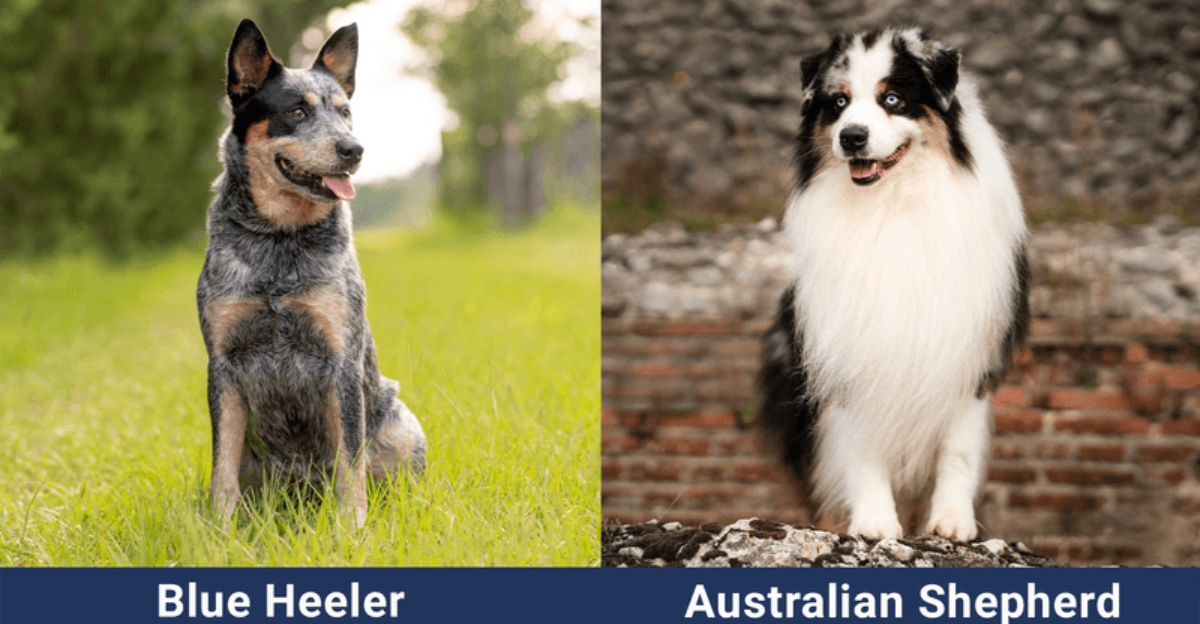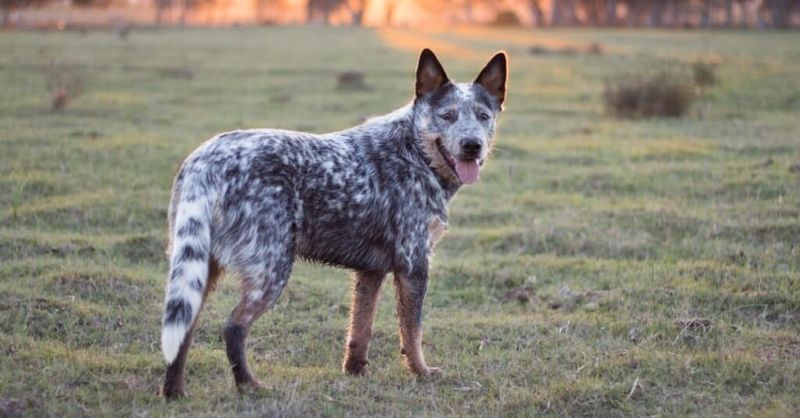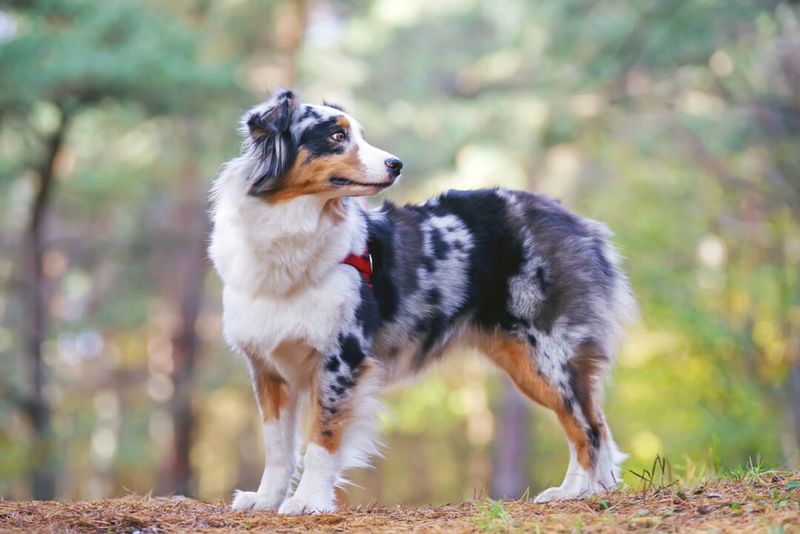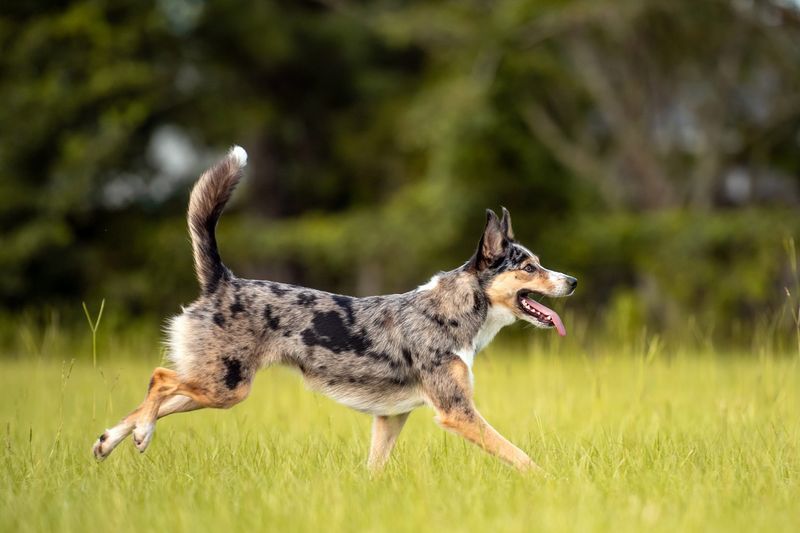Blue Heelers and Australian Shepherds are two popular breeds known for their intelligence, energy, and versatility. While they share some similarities, there are key differences that potential dog owners should be aware of. Understanding these differences can help you decide which breed is the perfect fit for your lifestyle.
Size and Build
Blue Heelers typically exhibit a compact and muscular build, standing around 17 to 20 inches at the shoulder. Their sturdy frame is designed for endurance and agility. Meanwhile, the Australian Shepherd tends to be slightly larger, ranging from 18 to 23 inches tall. This breed possesses a more flexible and athletic physique, ideal for herding tasks that require quick movements. Both breeds, with their unique builds, cater to different preferences and needs. Whether you seek a robust companion or an agile partner, these breeds offer versatility in size and structure.
Coat and Color Patterns
Adorned with a short, dense coat, the Blue Heeler showcases a striking blue or red speckle pattern, often with vibrant patches. This coat offers protection against harsh weather and rugged terrain. The Australian Shepherd, however, boasts a longer, woollier coat with a spectrum of colors, including blue merle, black, red merle, and red. Their coats often include unique patterns and markings, giving each dog an individual appearance. These differences in coat types and colors can influence owners’ grooming routines and aesthetic preferences, making each breed appealing in its own way.
Energy Levels
Renowned for their boundless energy, Blue Heelers are like dynamo machines, always ready for action. They thrive in environments where they can expend energy through physical and mental challenges. Meanwhile, Australian Shepherds, while equally energetic, possess a more balanced temperament. They enjoy active play but can also relax when needed. This difference in energy levels means prospective owners should evaluate their own activity levels before choosing a breed. Whether you prefer constant adventure or a mix of activity and rest, understanding these traits ensures a harmonious relationship with your pet.
Intelligence and Trainability
Both breeds excel in intelligence, yet their trainability can vary. Blue Heelers possess a sharp mind, often requiring firm and consistent training to harness their independent nature. They thrive with clear tasks and responsibilities. On the other hand, Australian Shepherds are eager learners, often excelling in obedience and agility training with their cooperative demeanor. This distinction can guide potential owners in training approaches, whether they seek a dog that challenges them or one that’s eager to please. These intelligent companions will keep owners engaged and fulfilled while highlighting their unique cognitive strengths.
Origin and History
The Blue Heeler, also known as the Australian Cattle Dog, hails from the vast outback of Australia. Originally bred for herding cattle, this breed is renowned for its endurance and resilience. In contrast, the Australian Shepherd, despite its name, was developed in the United States during the 19th century. It found its place on ranches and rodeos, herding livestock. These breeds’ distinct histories contribute significantly to their unique traits. The Blue Heeler’s rugged nature contrasts with the Australian Shepherd’s more versatile herding skills, providing dog owners with diverse choices for work and companionship.
Temperament and Socialization
Blue Heelers are loyal and protective, often forming strong bonds with their owners. They may be wary of strangers but are fiercely devoted. Conversely, Australian Shepherds are generally more sociable and outgoing, enjoying interactions with both humans and other animals. This temperament variance means socialization is crucial for Blue Heelers from a young age, whereas Australian Shepherds naturally adapt to social settings. Understanding these temperamental traits helps potential owners foster environments where their dogs feel secure and loved, enhancing the bond between dog and human.
Grooming Needs
Blue Heelers boast a low-maintenance coat, requiring minimal brushing to remove loose hairs. Their short, dense coat is designed for practicality over aesthetics. In contrast, Australian Shepherds demand more grooming attention, with their longer coats needing regular brushing to prevent matting and tangles. This grooming necessity can impact a potential owner’s routine, with Australian Shepherds requiring more time and effort to maintain their coats’ health and appearance. Choosing between these breeds may hinge on the owner’s willingness to commit to consistent grooming sessions, balancing practicality with beauty.
Health and Lifespan
Both breeds generally enjoy robust health, though they each have unique health concerns. Blue Heelers are prone to hip dysplasia and progressive retinal atrophy, conditions that require vigilance. Australian Shepherds may face issues like epilepsy and cataracts. Proper healthcare and regular vet visits are essential for both breeds to ensure a long, healthy life. Typically, Blue Heelers live around 12 to 16 years, while Australian Shepherds enjoy a lifespan of 12 to 15 years. Understanding these health factors equips owners with the knowledge to provide optimal care, nurturing longevity and vitality.
Adaptability to Environment
Blue Heelers adapt well to rural environments with ample space for exploration and activity. Their rugged nature aligns with outdoor living, making them ideal for farms and countryside homes. Meanwhile, Australian Shepherds are more adaptable to various living situations, including urban settings. They thrive in environments that balance physical activity and mental stimulation. This adaptability difference guides prospective owners in choosing a breed that fits their living conditions, ensuring the dog’s well-being and happiness. Whether rural or urban, each breed offers unique strengths for their respective environments.
Role in Family Life
Both breeds can be wonderful family pets, but their roles may differ. Blue Heelers often assume a guardian role, vigilant and protective of their family unit. They may bond strongest with one person, showcasing loyalty. Australian Shepherds, with their sociable demeanor, integrate seamlessly into family life, enjoying interactions with all members. They thrive on companionship and play, making them delightful additions to families. Knowing these roles helps families choose a breed that complements their dynamic, whether seeking a protector or a playful companion. Each breed brings its own unique charm to family life.
Exercise Requirements
Both breeds require ample exercise to stay happy and healthy. Blue Heelers thrive on high-energy activities, needing regular physical challenges to satisfy their working instincts. Their exercise routines should include tasks that engage both mind and body. Australian Shepherds also demand exercise but enjoy a mix of structured activities and playful engagement. Understanding these exercise needs aids in selecting a breed that aligns with an owner’s lifestyle, ensuring both dog and owner enjoy a fulfilling, active partnership. Whether through running, agility, or play, these breeds need active outlets to flourish.











